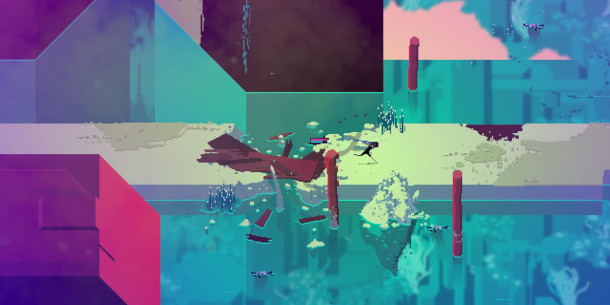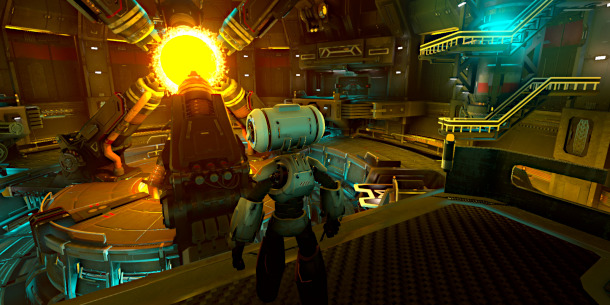Godot 3.2 ships

An image from Resolutiion, Monolith of Minds’ upcoming action-RPG, created using Godot 3.x, and used by the Godot team to announce the first alpha release of Godot 3.2.
Originally posted on 14 October 2019. Scroll down for news of the final release.
The Godot team has released Godot 3.2, the next big update to the open-source game engine, in alpha.
The update introduces a redesigned visual shader editor, support for texture atlases and pseudo-3D depth in the engine’s 2D toolset, and a lot of nice workflow and performance improvements.
There is currently no official timescale for the production-ready build, but if Godot 3.2 follows the same pattern as previous updates, expect the final release in around six months.
A powerful open-source alternative to Unity for 2D and 3D titles
Originally developed in-house at Argentinian game developer Okam Studio, Godot provides an open-source alternative to Unity, and is currently being used on a range of indie and mobile games, both 2D and 3D.
Since going open-source in 2014, work on Godot has been steadily accelerating, in part thanks to funding from Mozilla and Microsoft, with the team hiring its third full-time core developer last month.
Earlier this year, it became the de facto open-source game engine, with the Blender Foundation removing its own game engine from Blender 2.80 and recommending Godot as a “more powerful alternative”.
New in Godot 3.2: redesigned visual shader editor
Godot 3.2 continues the work on the visual shader editor begun in the previous release.
One major usability change is support for a drag-and-drop workflow: the old menu for adding nodes to the shader graph has been replaced with a tree-based pop-up from which nodes can be dragged in.
It is also now possible to cut and paste nodes, and to delete multiple nodes at once.
There are also a number of new node types, ranging from mathematical functions to Boolean operators and greyscale and sepia render effects.
It is also now easier to go from the graph to shader code, with a new Expression node making it possible to write code directly within the graph, and the option to preview the code generated by a shader.
In related news, updates to environment mapping should mean that scenes containing PBR materials look more consistent with the way that they do in other real-time PBR engines, like Blender’s Eevee renderer.
Improved collision mesh generation and 3D file import
Other new 3D features include support for convex decomposition using the VHACD algorithm, which generates more accurate collision meshes from 3D objects than the existing implementation.
Under the hood, Godot now uses the Open Asset Import Library (Assimp) to import scenes, which provides support for most common 3D file formats, including FBX and glTF 2.0.
The engine now supports skeleton skins when importing glTF 2.0 and FBX scenes, making it possible for multiple meshes to share a single skeleton.
New 2D features: support for texture atlases and pseudo-3D effects
Godot’s 2D toolset also gets a sizeable update, with support for 2D texture atlases – one of the features lost in the compatibility-breaking Godot 3.0 update – now having been reinstated.
There is also an experimental new 3D layer system within the 2D engine, intended to enable developers to create pseudo-3D effects within 2D games, as in the video above.
Other changes include the option to convert a sprite to a Mesh2D, Polygon2D, CollisionPolygon2D or LightOccluder2D object in order to interact with a game’s physics and lighting systems.
There are also a number of nice smaller usability features, including a new ruler tool in the 2D editor and the option to reorder animation frames by dragging,
New developer features, audio tools and extended support for AR and VR
Developers also get a number of important new features, including integrated version control in the editor, and a new network profiler to help troubleshoot multiplayer games.
New audio features include support for generating audio procedurally, and a new spectrum analyser.
Godot 3.2 also introduces WebRTC support for developing multiplayer browser games, a new plugin system for Android projects, plus new AR and VR functionality, including support for Apple’s ARKit platform and support for Gear VR, Oculus Go and Oculus Quest headsets.

Updated 30 January 2020: Godot 3.2 is now available as a stable release.
The 3.2 branch of the code will now receive long-term support as the developers prepare for the milestone Godot 4.0 release and its compatibility-breaking Vulkan-based rendering backend.
According to the blog post announcing the update, “upgrading projects from Godot 3.2 over to Godot 4.0 will require significant work”.
“The scope of the changes won’t be near as bad as it was [between Godot 2.1 and 3.0] but we still expect many users will choose to stay on the Godot 3.2 branch if they are happy enough with its feature set.
Availability
Godot 3.2 is available for 32-bit and 64-bit Windows and Linux, and macOS.
Read an overview of the new features in Godot 3.2 on the Godot team’s blog
Read a full list of new features in Godot 3.2 in the online changelog
